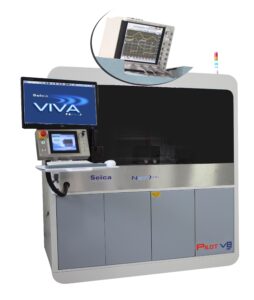PILOT V8 HR TO TEST HF WITH 10 MEGAPIXEL HIGH RESOLUTION CAMERA
Current electronics trend shows a major direction for the board production: miniaturization. More products have now very small dimensions and the request of testing becomes more demanding on mechanical aspects than in electrical measurement difficulties
What is MEMS Technology?
Micro-Electro-Mechanical Systems, or MEMS, is a technology that in its most general form can be defined as miniaturized mechanical and electro-mechanical elements. The technological challenge in testing these objects find a solution in the CAD data management expertise, with the target to generate automatically a test program, starting from a mix of electrical and mechanical information.
The solution for this application is the Flying probe technology, integrating the high accuracy of positioning probes on the UUT and the capability of the probe to land with a perfect control of the pressure. Based on the consolidated and complete solution of the Seica Flying Probes line, the PILOT V8HR includes the performance of a 10 MegaPixel High Resolution camera and a dedicated Z-axes control.
The PILOT V8HR vertical architecture is the optimum solution for probing both sides of the UUT simultaneously. The reliable and repeatable dual-side probing increases test accessibility and flexibility, while guarantees the complete continuity tests from side to side of the UUT. The vertical architecture represents the unique technology overcoming the intrinsic limitations of the horizontal systems. The requirement for standard ICT & Functional testing of the DUT is still part of the basic requirement and is satisfied using the Seica proprietary hardware: ACL measurement card with 18 bit resolution and switching matrix allow to reach most the testing requirement, remaining a solid base for any future expansion capabilities.
The test techniques of the PILOT V8HR include:
• FNODE signature analysis on the nets of the UUT
• Standard analog and digital in-circuit test
• Vectorless tests (JSCAN and OPENFIX), to test ICs for opens and shorts
• PWMON net analysis for power on the boards
• Continuity test to detect open tracks on the PCB
• Visual tests for component presence/absence and rotation
• Optional Thermal Scan Resources
• ALI: Automatic Laser Inspection for testing the presence / absence of components and for warpage compensation
• Up to 20 GSa/s depending of the instrument selected
• Active probe amplifier



